|
Some witnesses are immortal works, and are easy to find either in modern printing, pocket books or even old edition. The majority of the works presented below are really among the best that have been written on this theme, even if I personally think that some less known books conceal even more emotion and speak just. But for somebody willing to limit himself to the reading of a few volumes, those next will make the deal perfectly.
My first literary contact with the Great War goes back to my 14 years, and is due to the talent of Maurice Genevoix. In his memories written in 1917, which are gathered in a collection entitled ' Those of 14 ', this young second lieutenant of the 106e regiment of infantry of the French Army tells the first battle of the Marne (on the right wing – that is in the sector of Verdun), then those of ‘Les Eparges’ and of ‘La Tranchée de Calonne’ (south of Verdun) in 1914 and 1915. 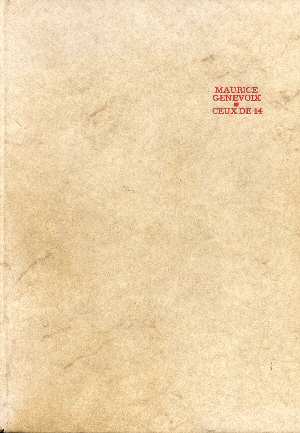
Badly wounded and then disabled in 1915, Maurice Genevoix became afterwards a brilliant writer, shining with his own moving and natural style, and accepted the title of Permanent Secretary of the French Academy. He died in 1980, after having been one of most brilliant and active organizers of associations of ex-soldiers.
In addition to the purely literary success, its work is particularly moving, and one follows the evolution of his feelings as the war slowly sticks in the mud, passing from the fighting in the countryside to the ugly mining war, bloody mud and frontal attacks against formidable entrenchments.
Read this book, then go for a walk on the battlefield of ‘Les Eparges’, of which the mine craters, the shell holes, the trenches remains, and the monuments marking the strategic points conquered in blood will become familiar to you... A terrible shock awaits you in ‘Le Trottoir’ cemetery, at the feet of the damned hill, when you discover there the tomb of the young lieutenant Porchon, who you saw, laughing, suffering and dying by the side of his friend Maurice, throughout the pages of this book. How easy to imagine the emotion of Genevoix at the same place, after the war… How easy to feel real compassion for both the dead and the survivor ?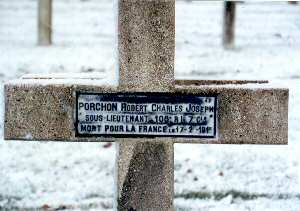
A terrible shock awaits you in ‘Le Trottoir’ cemetery, at the feet of the damned hill, when you discover there the tomb of the young lieutenant Porchon, who you saw, laughing, suffering and dying by the side of his friend Maurice, throughout the pages of this book. How easy to imagine the emotion of Genevoix at the same place, after the war… How easy to feel real compassion for both the dead and the survivor ?
A Must among the Musts, and in the center of many polemics among ex-serviceman, ' The Fire - Notebook of an Escouade ', of Henri Barbusse has been my second shock. Enrolled as a volunteer soldier, stretcher-bearer with the 231e regiment of infantry, Barbusse lived the mobilization and the furious fights of Artois in 1915. That experience gives the heart of this novel.
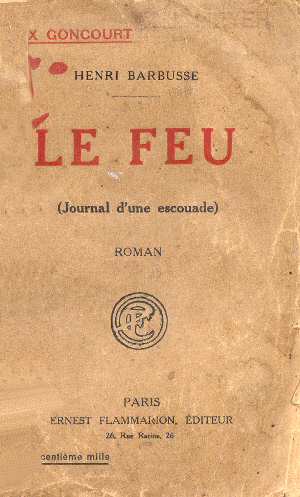
Though its detractors, whose most virulent one was the criticist and ex-soldier Jean Norton Cru, demonstrated that the characters of its heroes was too much a caricature, and to have exaggerated the macabre aspect of the described situations, it remains that this work is a strong text, that one takes in full chest.
It is about the war of the small soldiers, thrown from a part of the hell to another one without any idea of their contribution to the tactic nor strategy, stucked in mud and evolving in the medium of stinking dead bodies. But alive, suffering and philosophizing crushed by the falling hurling shells.
The probability that the author did not respect the exact truth here and there is very likely. The fact that this upset certain witnesses of the same period who felt betrayed, is comprehensible. But the piece is a really moving work, written quite well (it received the Goncourt price in 1916, in spite of its anti-warmonger coloration), which one does not leave intact. Committed Communist (his death in 1935 in Moscow, was greeted by Joseph Stalin in person), Barbusse created a book which conceals passages of pure emotion;
Read this extract, where the hero attends by far a French attack under a heavy shelling :
"One distinguishes fragments of lines made of these human points that left the hollow lines, move on the plain under the horrible unchained sky. One can hardly believe that each one of these tiny spots is a human being made of shivering and fragile flesh, infinitely disarmed in space, and who is full with a major thought, full with long memories, and full with a crowd of images; one is dazzled by that dust of men as small as stars of the sky.
Poor brothers, the unknown poor, it is your turn to give! Another time it will be ours. Our turn tomorrow, perhaps, to feel skies exploding on our heads or the ground opening under our feet, to be attacked by the extraordinary army of projectiles, and to be swept by breaths of hurricane a hundred and thousand times stronger than the hurricane.."
Less caricatural in its characters than was 'Le Feu ', this second classic novel ' Les Croix de Bois’, written this time by Roland Dorgelès in 1919, attacked anyway the same level of criticisms. Considered to be too black, too bloody, by ex-soldiers, it was despite all that a successful best-seller. 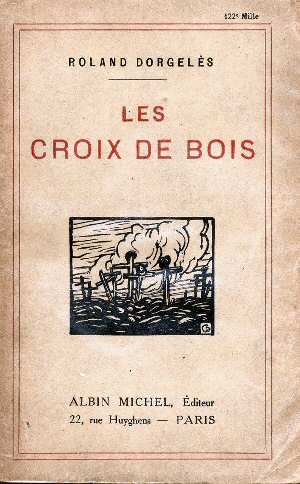
Dorgelès also took an active part in the beginning of the War, and also attended the combat of Artois in 1915 within the 39e regiment of infantry. Appointed machine gunner Corporal in July 1915, he will be transferred in 1916 in aviation, but never flew, because of a wound.
Its novel introduces fictitious characters, among whom the one called Sulphart holds a central role. Here again the images of horror strike as strongly as the description of the infinite misery of these men. No glory, not heroism, just of the suffering and revolt against the war... As a proof, this quotation took from the last pages of the work, when Sulphart, at the counter of a pub after the celebration of the ‘Victoire’ in 1918 in Paris, cuts violently a discussion on the value of the victory, declaring :
"I think it is a victory, because I went through alive...."
. TheBattlefields of Artois, where the principal action of these two books (' Le Feu' and ' Les Croix de Bois ') takes place are interesting to visit. Carency, Souchez, La Targette, the Labyrinth, the White Works, Notre Dame of Lorette, so many places whose names you will know from the books, that you can visit. After 1915, the sector was held by the English and Canadian troops, and the fightings they had wrote another page in letters of blood (remember the capture of the Vimy Ridge in April 1917). There also many monuments of this time to be found...
And here the last work that I recommend as first reading to discover what 14-18 was in the trenches on the French side. 'La Peur' was written well after the war (in 1930) by Gabriel Chevallier who became celeb by its literary work, whose principal success was ' Clochemerle '. Enrolled at 19 years old in 1914, he was wounded in 1915. Returning to the front line in 1916, he was at the end of the war in the infantry. ‘La Peur’ is thus an autobiographical novel at the first person, integrating the memories of war of the author, although the hero is named 'Jean Dartemont '.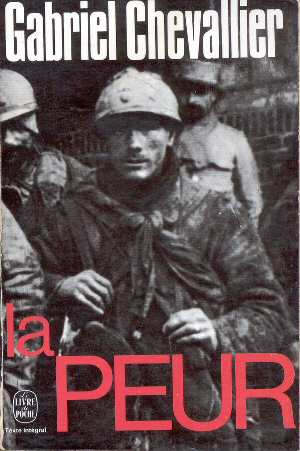
The story starts in 1914, with a seizing description of the foolish enthusiasm of August :
"One said to the Germans: ' Stand up, for the fresh and merry war! Nach Paris and God with us, for Gross Deutschland'. And the heavy peaceful Germans, who take everything as serious things, shook for the conquest, changed themselves in wild animals.and is completed in 1918, by the entry of the French troops in Germany.
. One said to the French ' They attacks us. It is the war of the Right and Revenge. A Berlin!' And the pacifist French, the French who take nothing as serious things, stopped their dreaming of small capital owners to go to fight. (...)
Twenty million, all with sincere faith, all in agreement with God and their Prince... Twenty million imbeciles... Like me!" Twenty million, all with sincere faith, all in agreement with God and their Prince... Twenty million imbeciles... Like me!"
Between these two dates, the life in rest places, the sufferings on the front line, including an incredible description of the anguish of the infantryman watching for the noises made by tools of the German pioneers under his trench in ‘Berry au Bac’, horribly fearing the inescapable moment where the mine will jump and transform all into light...
Defeated country, white bleed by the Versailles treaty, torn by the civil war, and finally choked by Nazism, post-war period in Germany was not very prolific in war memories. I recommend two classic works that locate at the extremities of this time feelings..
19 year old officer in the elite German troops (following a brief experience before war in the Legion Etrangère !), Ernst Jünger lived the conflict on the western front, and was involved in many hard fights. He was rewarded by the ' For the Merit ' Cross ... and 14 wounds ! Not really astonishing then that ' Storms of Steel’ is resolutely more warlike than most of the classic French authors, sometime so much than its reading can become somehow disturbing. However, it gives a good idea of the determination of these soldiers, the violence and misery of this time.
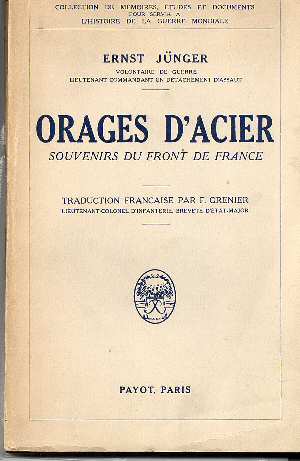 The fact that this work was written shortly after the armistice, and that many German fighters lived like a treason from home (the 'knife stabbing in the neck'), probably partly justifies this need to show the combat like an horrible experience, certainly, but carried out by courageous men.
The fact that this work was written shortly after the armistice, and that many German fighters lived like a treason from home (the 'knife stabbing in the neck'), probably partly justifies this need to show the combat like an horrible experience, certainly, but carried out by courageous men.
Fights in Champagne, Picardy, Somme, Les Eparges, are described with strength and a male tone. Ernst Jünger afterwards wrote some other books, among which other war memories ('Small wood 125 ') and a novel always inspired by his war experience (' Lieutenant Sturm '). These works all are regularly republished.
Jünger could avoid the advantage taking of its work by the Nazi movement, and took distance with it while deeply remaining nationalist. He took part to the second world war with the rank of captain, was involved in the plot against Hitler in 1944, and nearly lost his life because of this.
Young 18 years old volunteer enrolled in 1915, E-M Remarque wrote with 'Nothing New on the Western Front' an indictment against the war, based on his own experience. All there leads to make us sick with that cruelty. The bounding fear, the blood mixed with mud, the howls of the wounded ones, the dirtiness, the stench is everywhere.
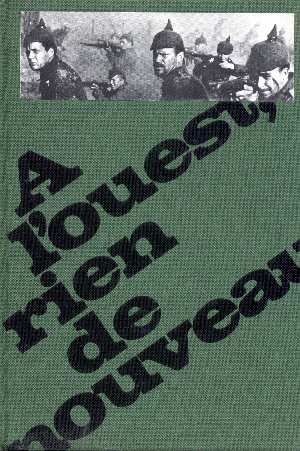 The beginning of the book could be alone the reason for reading. The ignited nationalist words of propaganda of college professor, sending his young students to the doom on the western front are edifying. The following of the book shows the hero losing very quickly his illusions of heroism, and being unrelentingly drifted in terror and dislike.
The beginning of the book could be alone the reason for reading. The ignited nationalist words of propaganda of college professor, sending his young students to the doom on the western front are edifying. The following of the book shows the hero losing very quickly his illusions of heroism, and being unrelentingly drifted in terror and dislike.
At the time of its printing in 1929, this book was universally celebrated as a pacifist masterpiece and had an tremendous success. But it did not gather only supporters. In France, the very intransigent Jean Norton-Cru made him a disciple of Barbusse who took pleasure to the expression of the horror and sensational things, deforming the reality.
In Germany, E-m Remarque was hated by the nationalists, who found in the pessimism of his work a proof of cowardice and identified him as one of the defeatists who brought the rapid 1918 collapse. The Nazis further prohibited and burned this work, registering its author on a list of writers considered as declining, symptomatic of the 'declining moral' and ' cultural Bolchevism '. When Adolf Hitler took the lead, in 1933, Remarque exiled like many others in the United States, probably avoiding the concentration camp. He gained the American nationality in 1947.
A lot of books have been written in the United Kingdom by ex-soldiers of all ranks. Unfortunately, quite a small amount of them was translated in French (so bad for french-speaking amateurs). I will thus restrict myself to quote two of my readings
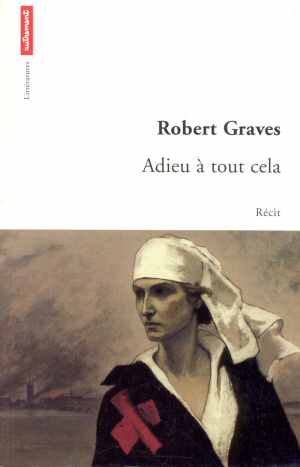 Robert Graves was 19 years old and already a ‘gentleman’ when he left home to fight as an officer in the British Army in 1914. During the terrible battle of the Somme, on the July 20, 1916 in the Throne Wood close to Bazentin, he was so badly wounded that the army officially announced its death to his family. He recovered from its wounds and continued the conflict.
Robert Graves was 19 years old and already a ‘gentleman’ when he left home to fight as an officer in the British Army in 1914. During the terrible battle of the Somme, on the July 20, 1916 in the Throne Wood close to Bazentin, he was so badly wounded that the army officially announced its death to his family. He recovered from its wounds and continued the conflict.
Cultivated man and correspondent of the famous Siegfried Sassoon who created in the trenches some of most incredible war poems, Robert Graves wrote in this work his memories, the war constituting the major part of it. The tone is very ' British'. Humour and self-derision alternates with fear and pain. This terrible test left this young man traumatized, and the story of the following years of his life is only used to show the extent of the damages.
We can say then that "Goodbye to all that" is an self-made exorcism of a 33 year old young man,11 years only after the end of a war that transformed his life. It is necessary to understand and be impregnated with that idea to appreciate the best this work, and to feel the suffering and the horror crouched in elegance and style.
This book is made with the memories of an English officer sent on intelligence mission in the Arab peninsula, in order to gather the divided tribes against Turkey, allied of Germany, during the war in the Middle East. T.E. Lawrence lived there an amazing adventure, that was exploited later by Hollywood in masterly "Lawrence of Arabia" interpreted by the unforgettable Peter O' Toole.
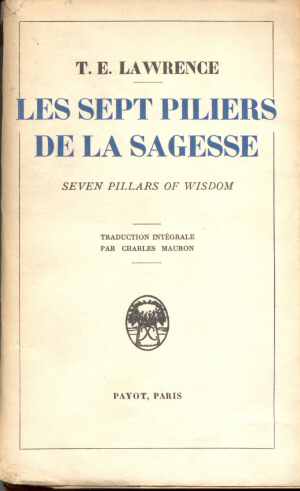 It is necessary to read 'The 7 Pillars of Wisdom' not only to realize that the Great War was also made of camel riding progressions and fights in the Jordanian desert, but also for its literary and philosophical value. In its first French translation (with Payot), this heavy volume weighs 820 pages! Fortunately, reduced versions have been published since that do not betray the original text.
It is necessary to read 'The 7 Pillars of Wisdom' not only to realize that the Great War was also made of camel riding progressions and fights in the Jordanian desert, but also for its literary and philosophical value. In its first French translation (with Payot), this heavy volume weighs 820 pages! Fortunately, reduced versions have been published since that do not betray the original text.
To federate the Arab tribes against Turkish, the British government asked Lawrence to make independence promises. But at the end of the conflict, they were quickly forgotten.. Lawrence, who developed a deep respect for the Arab culture and people never recovered from that wound.
This bitter disappointment is accurately transcribed in its book, in which the British 'realpolitik' is cruelly criticized. The specimen that I have was printed in France in 1941, during the German occupation : needless to say if the text criticizes the United Kingdom !
T.E. Lawrence died in an motor bike crash just before the second world war.